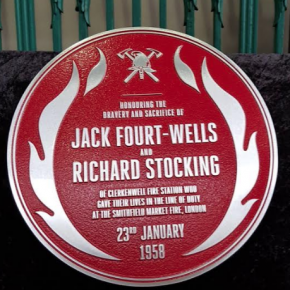
Remembering the Smithfield Fire with Wrightstyle
Jane Embury, Wrightstyle’s marketing director, takes a look at the Smithfield fire, which took place in London 60 years ago, causing the deaths of two firefighters, whilst changing policies on breathing apparatus.
It’s a fire that took place sixty years ago in London’s main meat market and cost two firefighters their lives.
The Smithfield fire burned for three days in January 1958, and also injured another two dozen firefighters. It was tackled by 1,700 firefighters and 389 appliances.
Following a review, policies on firefighter breathing apparatus were changed, replacing ‘Proto’ oxygen sets with compressed air breathing apparatus.
Since then, and as our understanding of fire dynamics has improved, procedures and firefighting equipment have further evolved to offer a greater margin of safety to building occupants and firefighters.
Essentially, fire safety in commercial buildings is down to three things: an alarm system to detect and warn of the danger, a sprinkler system to damp down the fire, and fireproof compartments to contain the fire at source and prevent it spreading.
Taken together, those active and passive elements are designed to allow occupants to escape from the building, and provide safe access for the fire and rescue services. How those elements are applied depends on the size of the building, its complexity and its function.
Whatever the building, compartmentation is fundamental to its safety, creating a series of protected fire zones to ensure that the fire is contained. At Smithfield, this simply didn’t happen.
Fire is spread through three methods: convection, conduction and radiation, of which convection is the most dangerous. This is when smoke from the fire becomes trapped by the roof, spreading in all directions to form a deepening layer. Smoke, rather than fire, is often the real danger.
Materials such as metal can absorb heat and transmit it to other rooms by conduction, where it can cause new fires to break out. Radiation transfers heat in the air, until it too sets off secondary fires, spreading the danger away from its original location.
Modern glazing systems can provide complete protection against convection, conduction and radiation – whether as curtain walling, or internal doors or fire screens – for up to two hours, giving more than enough time for a safe evacuation.
But building designers and specifiers must ensure that the glass and its framing systems have proven compatibility. That means insisting on comprehensive fire test certification that covers both elements.
In a fire, the glass and its frame have to function together to prevent the spread of fire, smoke or toxic gases. If one fails, both fail, with potentially catastrophic consequences.
At Wrightstyle, we’ve invested in fire certification in the UK, USA and Far East – a reflection of our global business, and our confidence in our systems’ performance.
We can’t prevent fire from happening. But we can prevent it from spreading, and that’s just as important.
Wrightstyle,
Unit 2&7 Banda Trading Estate,
Nursteed Road,
Devizes,
United Kingdom,
SN10 3DY
Visit Supplier's page
Latest news

11th April 2025
Don’t Do a Dave! It’s Time to Lock FIT Show 2025 in Your Calendar!
It’s that time again – FIT Show is back! You could be forgiven for thinking there won’t be much new to see when FIT Show returns to the NEC from 29 April – 1 May. Wrong!
Posted in Articles, Building Industry Events, Building Industry News, Building Products & Structures, Building Services, Continuing Professional Development (CPD's), Exhibitions and Conferences, Information Technology, Innovations & New Products, Restoration & Refurbishment, Retrofit & Renovation, Seminars, Training
11th April 2025
Insight Data: Boost construction success with project and prospect data
For those working in construction – in whatever capacity – the last few years haven’t been much fun. And according to the latest statistics, it would seem the challenges are continuing – Alex Tremlett, Insight Data’s Commercial Director, has more…
Posted in Articles, Building Industry News, Building Services, Information Technology, news, Research & Materials Testing
11th April 2025
ASSA ABLOY EMEIA: Learn how to tackle the security challenges of digitalising access with insights from industry experts
In a new series of videos, experts in various specialisms within ASSA ABLOY share their expertise on digital access, including the complexities to overcome and the range of benefits for those who get digital access right…
Posted in Access Control & Door Entry Systems, Architectural Ironmongery, Articles, Building Industry News, Building Products & Structures, Building Services, Doors, Facility Management & Building Services, Information Technology, Innovations & New Products, Posts, Restoration & Refurbishment, Retrofit & Renovation, Security and Fire Protection, Videos
10th April 2025
Geberit completes 150 Acts of Kindness
Geberit has raised nearly £14,000 for various charities through its ‘150 Acts of Kindness’ initiative, a year-long programme of fundraising and volunteering to mark the company’s 150th anniversary in 2024.
Posted in Articles, Bathrooms & Toilets, Bathrooms, Bedrooms & Washrooms, Building Industry Events, Building Industry News, Building Products & Structures, Building Services, Charity work, Drainage, Interiors, Pipes, Pipes & Fittings, Plumbing, Restoration & Refurbishment, Retrofit & Renovation
 Sign up:
Sign up: